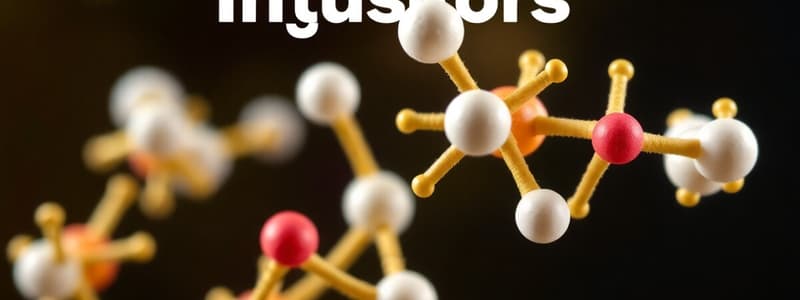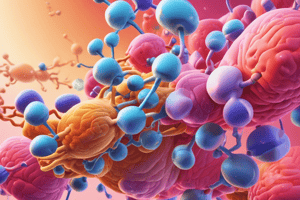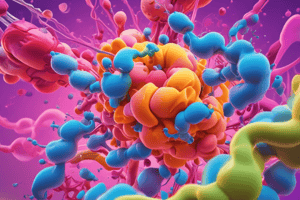Podcast
Questions and Answers
What is the underlying genetic cause of Duchenne muscular dystrophy (DMD)?
What is the underlying genetic cause of Duchenne muscular dystrophy (DMD)?
- An autosomal dominant mutation in the dystrophin gene
- A recessive X-linked mutation in the dystrophin gene (correct)
- A dominant Y-linked mutation affecting muscle function
- An XY linked mutation in the dystrophin gene
How does antisense therapy function in the treatment of DMD?
How does antisense therapy function in the treatment of DMD?
- It enhances the function of existing dystrophin
- It replaces dystrophin with a synthetic version
- It targets mRNA to increase dystrophin production (correct)
- It inhibits the production of dystrophin
What is the primary mechanism of action of cholinergic antagonists?
What is the primary mechanism of action of cholinergic antagonists?
- To increase the release of acetylcholine from motor neurons
- To block the action of acetylcholine on its receptors (correct)
- To enhance synaptic transmission at the neuromuscular junction
- To prevent the breakdown of acetylcholine in the synaptic cleft
Which of the following describes Myasthenia Gravis (MG)?
Which of the following describes Myasthenia Gravis (MG)?
What role do neuromuscular blocking agents (NMBAs) play in muscle physiology?
What role do neuromuscular blocking agents (NMBAs) play in muscle physiology?
What happens to an action potential when neuromuscular blocking agents are used?
What happens to an action potential when neuromuscular blocking agents are used?
Which of these statements is true regarding the mechanism of action of acetylcholinesterase (AChE) inhibitors?
Which of these statements is true regarding the mechanism of action of acetylcholinesterase (AChE) inhibitors?
In relation to muscle physiology, what is the consequence of dystrophin deficiency in DMD?
In relation to muscle physiology, what is the consequence of dystrophin deficiency in DMD?
What is the primary goal of Eteplirsen in the treatment of Duchenne muscular dystrophy?
What is the primary goal of Eteplirsen in the treatment of Duchenne muscular dystrophy?
What do indirect-acting cholinergic agonists primarily do?
What do indirect-acting cholinergic agonists primarily do?
Which of the following is a reversible acetylcholinesterase inhibitor that is short-acting?
Which of the following is a reversible acetylcholinesterase inhibitor that is short-acting?
In myasthenia gravis, what is primarily affected?
In myasthenia gravis, what is primarily affected?
What is the mechanism of action of physostigmine?
What is the mechanism of action of physostigmine?
Which adverse effect is commonly associated with the use of acetylcholinesterase inhibitors?
Which adverse effect is commonly associated with the use of acetylcholinesterase inhibitors?
What is the main clinical use of Edrophonium?
What is the main clinical use of Edrophonium?
Neostigmine is primarily used to manage symptoms of which condition?
Neostigmine is primarily used to manage symptoms of which condition?
Which type of neuromuscular blocking agent acts as a non-depolarizing antagonist?
Which type of neuromuscular blocking agent acts as a non-depolarizing antagonist?
Which condition is contraindicated for the use of physostigmine?
Which condition is contraindicated for the use of physostigmine?
Which class of drugs is used to block the effects of acetylcholine?
Which class of drugs is used to block the effects of acetylcholine?
What is the action of succinylcholine at the neuromuscular junction?
What is the action of succinylcholine at the neuromuscular junction?
What distinguishes non-depolarizing neuromuscular blocking agents from depolarizing agents?
What distinguishes non-depolarizing neuromuscular blocking agents from depolarizing agents?
Which neuromuscular blocking agent is known for having one of the shortest durations of action?
Which neuromuscular blocking agent is known for having one of the shortest durations of action?
Flashcards are hidden until you start studying
Study Notes
Cholinergic Agonists: Acetylcholinesterase Inhibitors
- Acetylcholinesterase (AChE) breaks down acetylcholine (ACh)
- Anticholinesterase drugs inhibit AChE, leading to ACh accumulation in the synaptic cleft
- There are three main types of anticholinesterase drugs: Edrophonium, Physostigmine, and Neostigmine
- Edrophonium is a short-acting AChE inhibitor, used for diagnosis of Myasthenia Gravis (MG)
- It binds reversibly to AChE, preventing ACh degradation
- IV injection leads to rapid increase in muscle strength, useful for MG diagnosis
- Physostigmine is an intermediate-acting AChE inhibitor
- It forms a stable intermediate with AChE, inhibiting its activity
- Results in increased cholinergic activity throughout the body
- Used to manage MG symptoms and for increasing intestinal and bladder motility
- Adverse effects include generalized cholinergic stimulation: salivation, flushing, decreased blood pressure, nausea, abdominal pain, diarrhea, and bronchospasm
- Contraindicated in intestinal/urinary bladder obstruction
- Neostigmine also reversibly inhibits AChE, with intermediate duration of action
- It is less absorbed orally and does not enter the CNS
- More effective in stimulating skeletal muscle compared to physostigmine
- Used to stimulate the bladder and GI tract, and to manage MG symptoms
- Similar adverse effects to physostigmine, and contraindicated in intestinal/urinary bladder obstruction
Therapy for Duchenne Muscular Dystrophy (DMD)
- DMD is caused by mutations in the dystrophin gene, leading to loss of dystrophin function
- Dystrophin is a protein that links the cytoskeleton to the sarcolemma, its absence leads to muscle fiber necrosis and wasting
- Eteplirsen is an "anti-sense therapy" for DMD
- It uses antisense oligonucleotides to target dystrophin pre-mRNA
- It binds to the pre-mRNA and alters splicing, leading to increased production of a partially functional dystrophin
- This increases the quantity of abnormal but functional dystrophin, potentially slowing the progression of DMD
Myasthenia Gravis (MG)
- An autoimmune disease affecting neuromuscular transmission
- Antibodies against nicotinic acetylcholine receptors interfere with normal signaling at the neuromuscular junction (NMJ)
- Results in muscle weakness, which can vary in severity
- Treatment includes anticholinesterase inhibitors
Studying That Suits You
Use AI to generate personalized quizzes and flashcards to suit your learning preferences.





